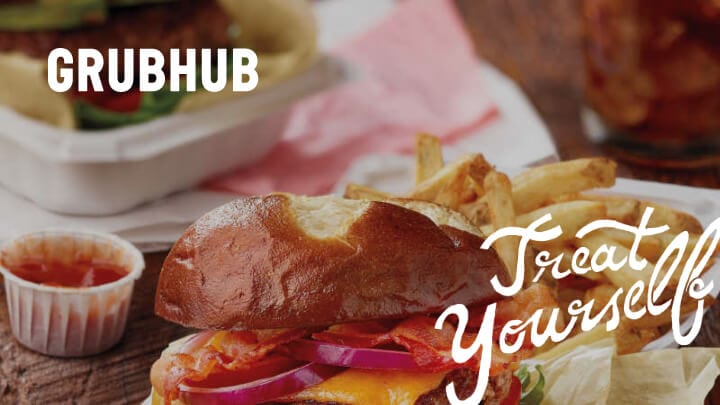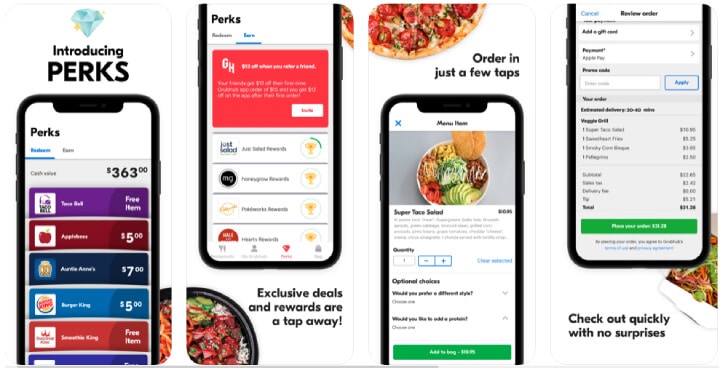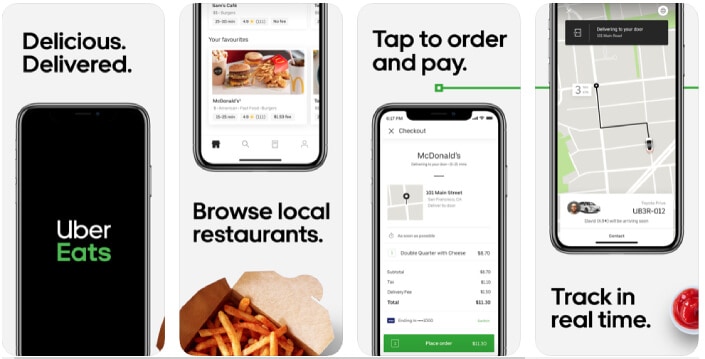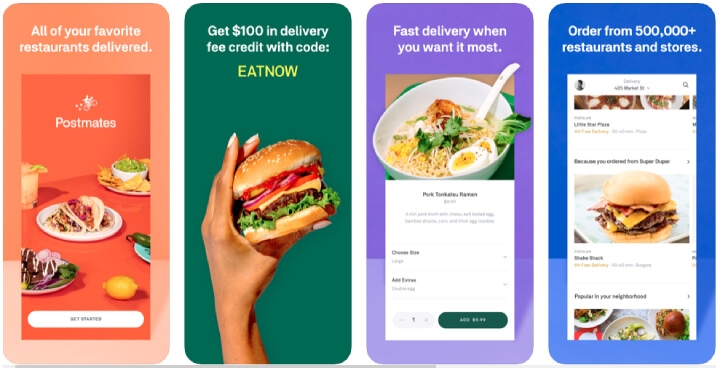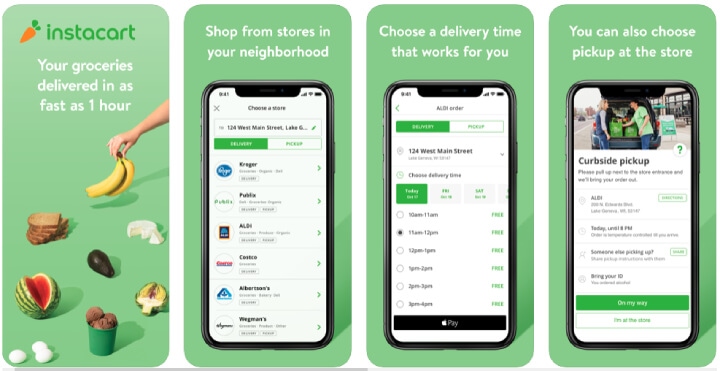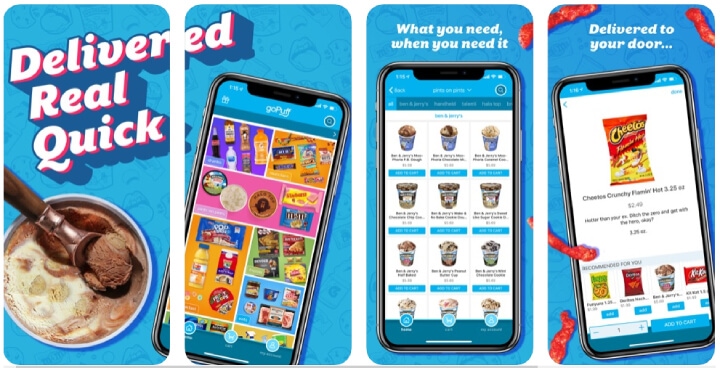
During the past decade, two primary factors have affected the food industry. Firstly, with busy lifestyles, the eating habits of the average person has completely changed. Secondly, with the growth in online technology, more and more people have switched from offline buying to online shopping and ordering, and the phenomenon has extended to ordering meals as well. While there are several apps in the fray, GrubHub has emerged as the leader among online food ordering and delivery platforms.
Facts and Statistics
- GrubHub began operations in 2004, initially offering its services only in Chicago
- App’s presence has grown to extend across over 1700 cities in the US & UK
- Around 95,000 restaurant partners are registered on GrubHub (2018)
- It had a user base of 17.69 million active diners in 2018
- On an average 457,300 daily orders are placed through the app
- Revenue grew from US$ 60.61 million in 2011 to US$ 493.33 million (2016)
- GrubHub has gained 50% online ordering & delivery market in the US (2017)
What does the GrubHub app offer?
The goal of the GrubHub app is to allow users to find and order food from wherever they are. Once they enter their current address, the app lists information on the various restaurants that deliver to the locality as well as options for restaurants that offer order pickup. Additionally, users can search by restaurant name, cuisine or even a specific item on the menu to receive filtered results.
Once the diners find what they want, they can place the order free of charge either online or over the phone. After the order is placed, the customer care team tracks it to ensure that the order is fulfilled according to expectations. Besides this, users also get access to a range of features such as coupons, deals, and reviews.
Business Model
Initially, GrubHub shied away from the commission-based model and instead chose to charge restaurants $140 for six months for premium placement on the website. However, when the approach didn’t receive the expected response from restaurants, the founders decided to switch to the commission-based model.
GrubHub’s primary source of revenue comes from commissions. Whenever a customer orders food online, GrubHub charges the restaurant a commission percentage for the order and delivery. The commission ranges from around 5% to 15%, averaging at approximately 13.05%.
Besides commission, the platform also offers marketing and advertising plans to restaurants so that they can be featured on the top of the list for a specific period. The plan is also linked to the commission structure, which means a restaurant that pays a higher commission gets priority for listing at the top.
The success of GrubHub’s business model lies in the value proposition it presents for restaurants and customers. For restaurants, online orders and takeaways are an excellent solution for growing their business without adding seating capacity or hiring additional staff, but the challenge lies in promoting takeaways by spending on advertising.
A listing on GrubHub presents a simple way to connect with local diners. Moreover, since GrubHub doesn’t charge any subscription fees, there is no upfront cost to be borne by the restaurant. Another benefit is that unlike other platforms, GrubHub doesn’t require the restaurants to offer discounts on the menu prices, and the restaurant pays a commission only when a customer orders. Therefore, it’s a low-risk proposition that provides efficiency and trackability, with the possibility of high returns.
For customers, GrubHub provides an easy-to-use and efficient interface to order online from local restaurants and track the order status until it is delivered. Additionally, it offers the convenience of storing order history and preferences as well as payment information for quick check out.
Why GrubHub still USA’s most popular?
Technology: When it was launched in 2004, in Chicago, GrubHub was a web-based platform that facilitated online food ordering and delivery. However, it has continuously updated its technology to offer improved customer experience. For instance, in 2010, to keep pace with the shift towards mobile adoption by customers, the company was quick to launch a mobile app.
Similarly, by considering the requirements of restaurants, the company launched a tablet app to help restaurants manage, confirm and complete orders, besides allowing them to update information such as menu items and business hours. Additionally, a separate app for the delivery team enables them to update status, send location information and reach out to the support team through chat.
Marketing: Unlike most online businesses and startups that rely entirely on online channels for marketing and advertising, GrubHub uses offline marketing in addition to online channels. For example, when they expanded to San Francisco (after initially launching in Chicago), the company placed posters and banners in public spaces such as subways, buses and other transit hubs where their target audience would see the ads when passing through the area.
Additionally, they have closely monitored the competition to replicate some of their successful strategies for marketing and product improvement to fuel growth.
Expansion: When the company expanded operations to San Francisco in 2007, they were aware of their lack of local expertise. To solve the issue, they hired a location manager with extensive knowledge of the San Francisco market. His responsibility was to build up the company’s network by visiting restaurants to get them to sign up for GrubHub.
Funding: When GrubHub first tasted success in the Chicago market, the team was turned down when it approached venture capitalists to fund expansion into other cities.
Instead of waiting for funding, the founders decided to use their own funds to expand to San Francisco. Even though it was a risky move, it paid off, as the company received its first funding a month after launching in the city.
Customer Support: The challenge with an online food ordering and delivery app is that the food needs to be delivered within an hour or so of the order being placed. To ensure that the orders are completed on time, the company employs customer care executives as well as automation tools that send an alert if the order isn’t confirmed within 5 minutes of being placed or if it hasn’t been dispatched within 20 minutes.
Accordingly, the customer care executives follow up with the restaurants to make sure that the order reaches the customer within the expected time.
Essential features
When designing a food ordering and delivery app, besides a fantastic UI/UX, the following are must-have, functional features:
Features for the User Panel
Registration: Customer sign-up and retention are key goals for any app. Therefore, it’s essential to have a simple and effective process that allows users to sign up or log in before they place an order. Besides allowing users to log in with email addresses or social media to protect privacy, reducing password constraints and other features that minimize user effort is ideal.
Smart search: In addition to searching for a restaurant by name, the app should allow users to filter results by type of cuisine, price or even a specific menu item to make it more user-friendly.
Order, scheduling, history: The process of browsing through restaurant options, menus and selecting items from the list should be simplified so that users can easily add items to their cart and check out without going back and forth between different screens.
Additionally, saving information about past orders, delivery addresses, and payment details makes the online ordering process smooth and efficient.
The app should have the option of scheduling delivery so that users can place an order ahead of time and specify the time when it should be delivered (such as when they return home after work).
The app should have a provision for the user to view order history, making it simpler to place repeat orders or get details of their favourite restaurants and menu items.
Easy and intuitive UI: The UI/UX design should be intuitive so that users can place their orders using on-screen tabs that allow them to choose items, add them to the cart, pay and check out without requiring instructions.
Favourites: Based on the analysis of the user’s previous orders and preferences, the app should automatically save local favourites, frequently ordered menu items and other details to make it easier for customers to repeat orders.
Real-time tracking: Once he places an order, using in-built GPS technology, the user should be able to track the status of the order, the exact location of the food delivered as well as the expected time for the delivery to be completed.
Coupons, deals, and promotions: With push notifications, app users can get information about location-based deals and promotions as well as coupons that offer them an incentive to order food online using the app.
Online support: Online chat support can enhance the customer experience during the process of food ordering or delivery. Customers can contact the customer care team by using the app to get help at any stage, whether it’s a delayed order or a wrong item delivered.
Easy payment options: To ensure a smooth checkout process, the app should allow multiple payment options, including wallets, credit cards and cash on delivery.
Features for the Restaurant Panel
Dashboard: The restaurant app should have a simple interface or dashboard that allows restaurant managers to track orders, payment status, and other important information onscreen.
Manage details: The app UI should be user-friendly, allowing users to update information such as adding new items to the menu, uploading images or changing prices.
Manage orders: Order management is an essential feature in a restaurant app as the manager can view the status of orders, review payment status and update the customer about the expected delivery time.
Manage deliveries: The app should have the provision of allowing the restaurant to assign deliveries easily and efficiently to the personnel or drivers registered on the app based on their location.
Features for the Driver Panel
Manage deliveries: Using the delivery app, the drivers or deliverers can see when they are assigned tasks and can choose whether to accept or reject new requests from the app interface.
Status update: They can use the app to update the status of the delivery to include details such as order pickup, transit time or delays, which then get sent via a push notification to the customer.
In-app navigation: GPS tracking and in-app navigation help the deliverer to find the delivery location easily, thereby enabling them to deliver the order on time.
Delivery history: Since deliverers or drivers work on a commission, the delivery history feature in the app helps them to keep track of order history as well as the amount of commission receivable on each order.
Designing Guidelines
Since a food order and delivery app has multiple components that need to be linked with restaurant and driver apps, it’s essential to follow a systematic approach to the design process.
Defining the scope: The first step is to analyze the problem or need for which the app will provide a solution. In this case, allowing users the convenience of placing online food orders from restaurants and getting them delivered to their location. The various features and functions should also be considered so that the scope of the design can be determined.
Understanding the process: Analyzing the existing apps or competitors gives a clear understanding of the app content as well as processes, providing insights into the direction that the development should take. Additionally, it allows identifying any existing gaps that the new app can fulfil.
Building wireframe, prototype, and design: In the initial stage of the app development wireframe help to present the basic architecture of the app in terms of design and content, based on which the layout and design can be planned. The final stage in the design process is to create a prototype or a mock-up that shows how the app will look once it’s developed.
Before designing the user interface of the app, in addition to following the colour and design preference of the client, it’s essential to review the existing food delivery apps to ensure that the design and the colour scheme of the new app has a unique identity.
Factors affecting the development cost
The Food Ordering app development cost for an app like GrubHub can vary depending on the platform, features and other factors.
Platform choice: The platform for which the food app is being developed can affect the overall cost. Firstly, it’s essential to decide whether to opt for a mobile or web-based online food order and delivery system. Additionally, for a mobile app, one should choose the platforms on which the app will be available – iOS, Android or both.
If the choice is to make it available on both iOS and Android, then one needs to decide whether to develop separate native apps for each platform or a single cross-platform mobile app that can work on both platforms.
App complexity: The number of features and the complexity of the app also influence the development cost. Additionally, for an app such as GrubHub, which has three different layers that are linked – one for the users to place orders, the second for the restaurant to manage orders, and the third for the deliverers – the cost can increase significantly.
Team size: The size of the app development team plays a role in the overall costs. In general, a reputed mobile app development company with a large team will incur higher overhead costs than a freelance developer or a smaller company.
Location of Development Company: It’s a well-known fact that companies in the UK, US, Canada, and Australia are more expensive than those in East Europe or India when it comes to app development costs.
On average, companies in the US, Canada, UK, and Australia charge between $50 to $300 per hour. In comparison, East European companies charge $30 to $150 per hour, whereas Indian companies charge between $10 and $80 per hour.
Also Read:
Things to Take Care of While Building Food Delivery Apps
How Food Delivery Apps are Benefitting from Big Data Analytics
GrubHub alternatives that are widely used by people
DoorDash
The mobile app, which is available on iOS and Android, features the largest number of restaurants, including local restaurants and national chains, offering food ordering and delivery to customers. That’s overall more than 110,000 restaurant menus from 1200 cities in the US and Canada.
However, it does not feature any premium restaurants. Although it doesn’t impose a minimum order value, the delivery fee can sometimes work out pricey with the inclusion of additional service charges and surge pricing.
Link: (Android | iOS | Web)
UberEats
Also available across iOS and Android, UberEats has a presence in most major cities worldwide. The services include the delivery of food orders from restaurants and grocery stores. The company charges a delivery fee of $5 per order. However, the amount can go up during busy times.
Link: (Android | iOS | Web)
Postmates
The app has iOS and Android versions and its services extend to most cities in the US as well as Mexico City. Orders are delivered to the doorstep for a fee, but customers also have the option of restaurant pickup, in which case, the fee is waived. The service extends beyond restaurant food to deliver groceries, gifts, and alcohol, among other things. Besides offering delivery from some of the high-end restaurants, which its competitors don’t provide, Postmates work 24/7 and will deliver food and drink so long as the restaurant or store is open and serving.
Link: (Android | iOS | Web)
Instacart
Instacart is a grocery delivery app that delivers within an hour. Besides delivering from many local stores, including Safeway, Shaw’s, Whole Foods, Costco and Super Fresh, among others, it offers customers the option of mixing items from more than one store in a single order. Delivery fees are $3.99 per order of $35 or more, besides a service fee of 5%. Alternatively, customers can opt for an Instacart Express membership for $99 per year to get free delivery.
Link: (Android | iOS | Web)
Seamless
Now owned by GrubHub, Seamless offers services only in New York City. The app functions are the same as those of GrubHub, which offers delivery to customers at no extra fee. Unlike GrubHub and some of its competitors, Seamless offers only 25 types of cuisines.
Link: (Android | iOS | Web)
goPuff
In comparison to GrubHub, goPuff is a convenient delivery service that delivers more than just snacks and drinks. The company’s services extend to over 100 locations in the US. Customers pay $1.99 per order, and unlike some of its competitors, it does not charge surge pricing.
Link: (Android | iOS | Web)
Wrapping Up
The reason for GrubHub’s success is that the company is focused on expanding to new territories and improving the experience for its customers. The company has followed a holistic approach to deliver through initiatives such as offering driver/delivery services to restaurants that don’t deliver, acquiring competing companies and even hiring independent delivery contractors. In other words, it has gone beyond just developing an app to offer integrated services in food ordering and delivery.
TechAhead, a leading mobile app development company is known to deliver high quality mobile apps for all platforms and frameworks. Contact our experts now to take your business to the next level.

